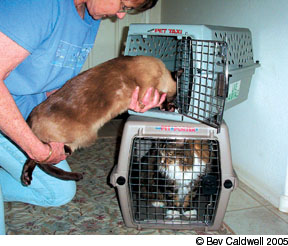During the terrible aftermath of Hurricane Katrina, a man managed to get back to his battered home after several days. He was shocked and overjoyed to see his cat – whom he had had to leave without – yowling in a window in a room that miraculously was not submerged or destroyed by the storm.

288
This lucky cat must have had nine lives plus. Sadly, many pets do not survive disasters when left behind at home. There is a misconception that animals somehow find a way to survive, says Carmine DiCenso, manager of the Boston Care and Adoption Center, Cape Cod region.
The Hurricane Katrina catastrophe has taught us a lot about what increases your – and your cats – chances for survival. And the key is in planning for a disaster before it happens, says DiCenso.
Take Your Pets With You!
Should disaster strike – hurricane, flood, wildfire or hazardous materials spill – the single most important thing you can do to protect your cat is to bring him with you, according to the Humane Society of the United States. Although we saw striking images of pets being rescued after Hurricane Katrina, most animals do not fare well when left behind in a disaster. Many cats are injured, lost or killed. And they are terrified as the disaster strikes. Cats left inside your home may escape through broken windows and then must fend for themselves while faced with exposure to the elements, predators and contaminated food or water.
Leave Before Youre Told To
As weve witnessed, its better to leave before a mandatory evacuation order. Even if you think you will only be gone for a few hours, its better to take your cat. You really have no idea what will happen, and conditions may prevent you from returning to get your cat.
Remember, in most cases, pets are not allowed in public emergency shelters, so you may have to make other arrangements beforehand. Contact your local animal shelter, humane society or veterinarian to find out if there will be any emergency animal shelters set up, pending the disaster, says DiCenso.
Another reason to act early upon hearing about an oncoming hurricane is that cats will often isolate themselves if they become afraid. If your pet is an outdoor cat, bring her in early to prevent her from running away. If you must leave your cat, leave a couple of weeks worth of food and water in the safest area of the house, says DiCenso.
Emergency Supplies for Your Cat
One of the most important things you will need in order to safely take your cat with you is a good cat carrier that allows your cat to stand up and turn around inside. Put in some of your cats favorite toys and blankets and even a piece of your clothing with your scent on it.
Identification for your cat is critical. Put a tag on your cats collar and on the cat carrier itself. Information should include your name, address, phone number, cell phone number and perhaps a phone number of a close relative. Most kennels also require proof of rabies and other vaccinations. If you leave your cat in a shelter or with someone who will be taking care of her, provide medical records and any instructions for special care your cat regularly needs. Recent photos of your cat will help locate and identify her if she is separated from you or moved to another safe area.
Dont forget your cats medication if she is taking any. Take along extra medications if you dont know long you may be away. Bring bowls and dry food for your cat. A water supply with a dispenser is important. So is kitty litter and a litter box.
During the Disaster
If you do have your pets with you, separate your cat from your dog. Even though your pets may get along famously during normal times, the stress of unfamiliar surroundings, lots of strange people and even other animals may cause your cat to experience extreme anxiety. He may react aggressively, so supervise your children when they play with your cat under these circumstances.
After the Danger Has Passed
Just as you may have to adjust to drastic changes in your home or neighborhood, so will your cat. When you temporarily settle in an area or are able to go back to your home, says DiCenso, gauge your cats behavior before you let her out of the carrier. Do not let your cat outdoors until you get official word that the environment is safe, says DiCenso.
Disasters are just that – disasters – and preparing for them is a lot of work. All members of your family will require supplies to sustain them. And your cat – a very special member of your family – is entitled to the same amount of preparation and care should a disaster occur.
For more information on planning for a disaster, see Pets and Disasters from the Federal Emergency Management Agency at www.fema.gov/library/petsf.shtm and Disaster Preparedness for Pets from the Humane Society of the United States at www.hsus.org/web-files/PDF/DIST_DisasterPetBrochure.pdf



